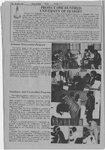| OCR Text |
Show The Broad Ax September Page 1975 21] MIRTH, MIRACLE OR MULTIPLICITY by Hoyte A. Coleman Research findings and expert opinions have led to numerous generalizations about the future of post-secondary education in major metropolitan areas. Significant progress toward “equal educational opportunity for all, regardless of need’’ will very likely be made to the extent that key individuals and agencies will be fully committed to develop- mental education, to adequate funding of developmental education, and to the control of inner-city colleges, including the programs offered, personnel hired, and evaluations made. Today, however, lack of commitments, inadequate financing, and overly centralized control are the key barriers to effective education for inner-city students. Many states are becoming more and more interested in establishing viable programs for students labeled ‘disadvantaged.’ Because of the pressures being applied by Congress on colleges to account for ex penditures, the concern has increased tremendously within the last several years. The big push today is for accountability. Recipients must begin not only to show what they are doing to improve the overall well being of the students but also to exemplify proper managerial application in fund expenditures. Expenditures and personnel correlate in measurable terms. progress must Some of us dealt directly with the problems of effective management, step-bystep assessment of progress, and effective evaluation. One of the major concerns from the beginning was how to determine in measurable terms the source of success of students who go on to higher academic. achievement. Is academic success attributed to what colleges are doing or is it due to students’ perseverance? Colleges must deal with these questions and must provide documental evidence to justify allocations. In providing such evidence, colleges should be reasonable. Disadvantaged students have built-in obstacles and societal pressures which have impeded their growth. Can one expect, for example, the same degree of competence from two individuals. if one has stumbling blocks placed in his path? If two equally capable vehicles left Hattisburg, Mississippi, enroute to Dallas, Texas, and one vehicle is required to make stops at New Orleans and Baton Rouge, while the other is free to take the most direct vehicle should reach Dallas first: route, which The answer is obvious. The vehicle required to take the circumventive route and stops is exceptionally fortunate if it arrives in Dallas within a reasonable students are time. Similarly, disadvantaged fortunate to make any progress in the current educational structure. Many people today are not aware of the encumberances disadvantaged students must overcome. They argue: ‘’These people don’t want to be helped”; or ‘‘They just can’t make the necessary adjustments”; or “If they want to excel, then they will, without outside intervention’: and on and on. The fact that only a small percentage of disadvantaged students are academically successful should not warrant termination of funds and innovative programs. If colleges are really interested in ‘‘equal education for all,’’ they should consider more effective evaluative procedures. My first paragraph was paraphrased from an excerpt written by Ernest G. Palola and Arthur R. Oswald in Urban Multi-Unit Community Colleges: Adaptation for the 70's, (Center for Research and Development in Higher Education, University of California, Berkley). Disadvantaged students are the individuals that we must bring through our educational viable process, providing for their exits as members of our society, not perpe- trator of welfare role increases. It is far easier to convince a panel of the need for fund transfers than it is to convince them of the need for new allocations. The mirth that our society does not have a large number of the disadvantaged the more people in the category of is a face-saving factor for affluent segments of our society. The evidence of the miraculous survival of disadvantaged students should, within itself, demand the employment of myriad methodOlogies for an undetermined amount of time to overcome the inequities that have pre| vailed. This | say! Allow views in this area. me to appreciate your Editor's Note: Hoyte A. Coleman is the. Director of the Special Services Program at Valencia Community College in Orlando Florida. |


























